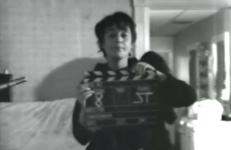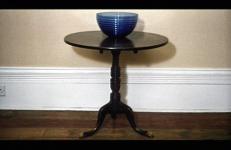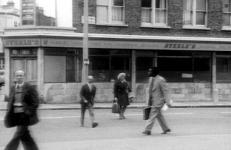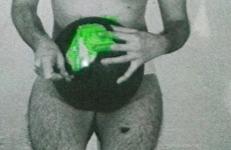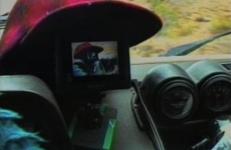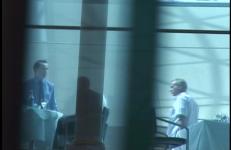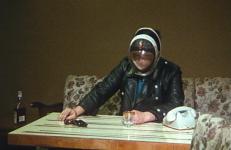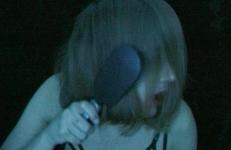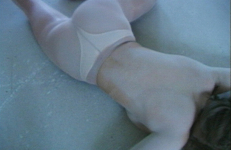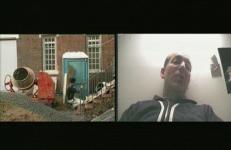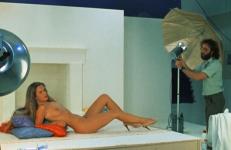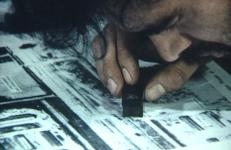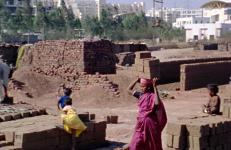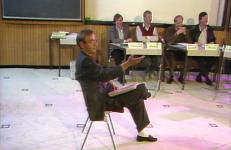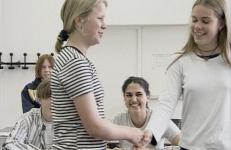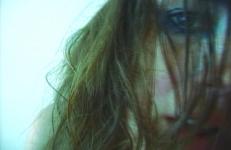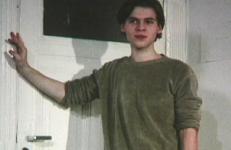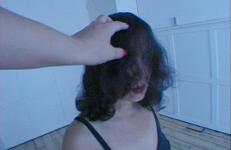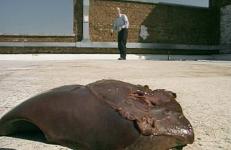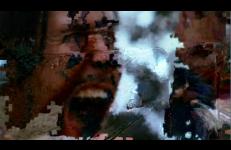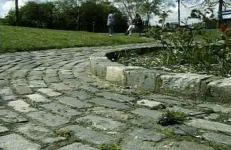German filmmaker Valeska and her crew—soundwoman Constanza and cameraman Albert—arrive at Maple Tree Farm during the Thanksgiving holiday of 1971 to film a piece for German TV on the Videofreex. In this video, the Videofreex turn the tables so to speak, making the Germans’ filming process—and the artificiality of the filmmaker’s prefabricated shots—their subject.
European Film/Video
Made in Ireland, October 8th, 2001.
A disorientating experience while attempting to watch the TV news in an Irish hotel room triggers a spontaneous response to the bombing of Afghanistan.
Frozen War is the first episode in the Hotel Diaries series, a collection of video recordings made in the world’s hotel rooms, which relate personal experiences and reflections to contemporary conflicts in the Middle East.
The filmmaker accepts the challenge of the philosopher and changes not only a table but also chairs, shoes, jugs, teapots and almost everything else lying around his house.
"What prevents me from supposing that this table either vanishes or alters its shape when no one is observing it and then when someone looks at it again changes back? But one feels like saying – who is going to suppose such a thing?"
— Ludwig Wittgenstein, On Certainty (Oxford: Blackwell, 1969)
“In The Girl Chewing Gum a commanding voiceover appears to direct the action in a busy London street. As the instructions become more absurd and fantasized, we realize that the supposed director (not the shot) is fictional; he only describes—not prescribes—the events that take place before him. Smith embraced the ‘spectre of narrative’ (suppressed by structural film) to play word against picture and chance against order.
A meditation on the nature of “Nature” and the uncertainty of “Cause and Effect.”
“Originally (like most of my earlier film work) this was a performance piece: text performed alongside the projected image. A complex and absurd ‘story’ about a man who thought there was something wrong with his eye. He goes to the doctor, who can’t help him much, but he finds a way he can operate on himself with uplifting yet troubling results.”
—Jennet Thomas
Super-8 and 8mm, film mattes, painting directly onto film, and model/object animation.
Spiro traveled for one year on the backroads of the southern United States gathering footage for this mobile video project. Accompanied by her dog Sam and a video camera, she travels from Virginia to Texas and back. Her van (which breaks down frequently) serves as office, apartment, editing suite, and runabout.
How Little We Know of Our Neighbours is an experimental documentary about Britain's Mass Observation Movement and its relationship to contemporary issues regarding surveillance, public self-disclosure, and privacy. At its center is a look at the multiple roles cameras have played in public space, starting in the 1880's, when the introduction of the hand-held camera brought photography out of the studio and into the street. For the first time one could be photographed casually in public without knowledge or consent.
The author assembles a genre picture of the contemporary FRG with shots of scenes where life is rehearsed, ability/durability is tested. Wherever one looks, people appear as actors playing themselves; they take on roles. A play in the theater of life made up of training courses, fitness tests for things and people. Be it in birth preparation classes for expectant parents or in practice runs for sales talks, on the military training ground or during role-plays for educational purposes. Everywhere the incessant effort to be prepared for the emergency of "reality" can be felt.
The title gives a bitter meaning to the uneasy image of a woman who is brushing her hair over her face with fierce movements. Mostly the face remains impersonally hidden under her hair; when it is uncovered, we see how the rough scratches of the brush against the skin have smeared her lipstick.
This title is also available on Hester Scheurwater Videoworks: Volume 1.
I Wanted You shows a woman who is crawling over the floor. She is wearing only tights and a pair of red shoes with high heels. Her hair-covered face makes her an anonymous victim of the camera, which is making converging circles around her body.
This title is also available on Hester Scheurwater Videoworks: Volume 1.
A comic monologue, I Was Once Involved in a Shit Show is a recollection of an imaginary art event that tallies with what most artists experience when they are involved in putting on an unfunded group show.
"Four days spent in a studio working on a centerfold photo for Playboy magazine provided the subject matter for my film. The magazine itself deals with culture, cars, a certain lifestyle. Maybe all those trappings are only there to cover up the naked woman. Maybe it's like with a paper-doll. The naked woman in the middle is a sun around which a system revolves: of culture, of business, of living!
The vanishing point of Images of The World is the conceptual image of the 'blind spot' of the evaluators of aerial footage of the IG Farben industrial plant taken by the Americans in 1944. Commentaries and notes on the photographs show that it was only decades later that the CIA noticed what the Allies hadn't wanted to see: that the Auschwitz concentration camp is depicted next to the industrial bombing target.
A young girl buys a weird toy from a charity shop. She forms such an intense relationship with it that it develops special ways of communicating and a strange connection to her that seems to defy the laws of physics. As the situation escalates, it seems that repression is the only way forward. First conceived of as a kind of fairy tale that goes wrong, this is a piece about learning the “rules” of grown-up reality and an extrapolation of the consequences of “over-identifying” with toys. A digital video with digital video effects, live-action, and model/object animation.
"Bricks are the resonating fundamentals of society. Bricks are layers of clay that sound like records, just simply too thick. Like records they appear in series, but every brick is slightly different – not just another brick in the wall. Bricks create spaces, organize social relations and store knowledge on social structures. They resonate in a way that tells us if they are good enough or not. Bricks form the fundamental sound of our societies, but we haven't learned to listen to them.
This film is about a five-day seminar designed to teach executives to "sell themselves" better. This course, designed for managers, teaches the basic rules of dialectics and rhetoric and provides training in body language, gesture and facial expression. The aim of selling something has always been a principle of mercantile action. Yet it was only through the marriage of psychology and modern capitalism that the idea of selling oneself was perfected.
-- Lutz Hachmeister
In the summer of 1996 we filmed application training courses in which one learns how to apply for a job. School drop outs, university graduates, people who have to be retrained, the long-term unemployed, recovered drug addicts and mid-term managers – all of them are supposed to learn how to how to market and sell themselves, a skill to which the term “self-management” is applied. The self is perhaps nothing but a metaphysical hook from which to hang a social identity.
The repeatedly distorted, primate behaviour of an (ani)female carrying her baby, reflecting the pain and suffering provoked by the mother/child relationship.
"This film is at once a self-portrait and an homage to Jean-Marie Straub, Farocki's role model and former teacher. Farocki's admiration for Straub was so great that he said of Between Two Wars, Perhaps I only made this film to earn Straub's recognition." In this observation-driven film, Farocki documents the fulfillment of his wish. The film shows Farocki, under Straub's direction, rehearsing for his role as Delamarche in the film Klassenverhältnisse (1983). Anyone who has seen Farocki's documentary of the shoot will never forget these short scenes.
Made with Ian Bourn.
A depiction of the forced development of a hothouse flower. Organic growth is progressively overtaken by a more sinister mechanical process.
"The makers manage very convincingly to wrong-foot the viewer in just five minutes in this minimalist, lyrical film about a blossoming flower."
—International Film Festival Rotterdam (2000)
"A film of a disarming seeming simplicity which enigmatically prompts reflections on its meaning and its use of media."
Two women occupy one space. Without showing their faces, the camera lingers on their bodies in images that capture both from an extreme high angle. The camera distorts the female body, even creating a grotesque effect. A voice repeatedly calls for a woman: “Lisa, come here, don’t be afraid… that’s it, I won’t hurt you.” A video which explores the gaze on the female body, and the desires and violence overwhelming it.
This title is also available on Hester Scheurwater Videoworks: Volume 1.
In this surreal experimental narrative, there’s something wrong with a patch of sky. As it travels over Southern England, objects cast up into it come down hugely enlarged, bloated. Meanwhile in London, the patch is in fact a troubling scab on a crippled old man’s head. As the scab develops, all he can do is wait, going through the changes, led on gently by the idiot-savant son with his childlike multiple identities.
Long Live the New Flesh uses found footage to transmogrify existing fragments from horror films into a new video. It deploys a digital technique with painterly quality in which the images literally consume one another and the horror in all its visual power is brought to a natural boiling point. Provost strips down the imagery of a mass medium, uses it to construct a new visual story behind the dissection and horror, and allows the viewer to cross every phase of the emotional spectrum.
Lost Sound documents fragments of discarded audio tape found by the artists within a small area of East London, combining the sound retrieved from each piece of tape with images of the place where it was found. The work explores the potential of chance, creating portraits of particular places by building formal, narrative, and musical connections between images and sounds, linked by the random discoveries of the tape samples.
Lost Sound documents fragments of discarded audio tape found by the artists within a small area of East London, combining the sound retrieved from each piece of tape with images of the place where it was found. The work explores the potential of chance, creating portraits of particular places by building formal, narrative, and musical connections between images and sounds, linked by the random discoveries of the tape samples.




